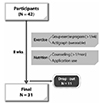References
1. Yun S, Kim HJ, Oh K. Trends in energy intake among Korean adults, 1998-2015: results from the Korea National Health and Nutrition Examination Survey. Nutr Res Pract 2017;11(2):147–154.
2. DeMarco VG, Aroor AR, Sowers JR. The pathophysiology of hypertension in patients with obesity. Nat Rev Endocrinol 2014;10(6):364–376.
3. Louie SM, Roberts LS, Nomura DK. Mechanisms linking obesity and cancer. Biochim Biophys Acta 2013;1831(10):1499–1508.
4. Menotti A, Puddu PE, Lanti M, Maiani G, Catasta G, Fidanza AA. Lifestyle habits and mortality from all and specific causes of death: 40-year follow-up in the Italian Rural Areas of the Seven Countries Study. J Nutr Health Aging 2014;18(3):314–321.
5. Takeshita T, Morimoto K. Effects of lifestyle on health status. Rinsho Byori 1995;43(11):1087–1094.
6. del Pilar Cruz-Domínguez M, González-Márquez F, Ayala-López EA, Vera-Lastra OL, Vargas-Rendón GH, Zárate-Amador A, et al. Overweigth, obesity, metabolic syndrome and waist/height index in health staff. Rev Med Inst Mex Seguro Soc 2015;53Suppl 1. :S36–S41.
7. Thorp AA, Owen N, Neuhaus M, Dunstan DW. Sedentary behaviors and subsequent health outcomes in adults a systematic review of longitudinal studies, 1996-2011. Am J Prev Med 2011;41(2):207–215.
8. Jakicic JM, Davis KK. Obesity and physical activity. Psychiatr Clin North Am 2011;34(4):829–840.
9. Expert Panel on Detection, Evaluation, and Treatment of High Blood Cholesterol in Adults. Executive Summary of The Third Report of The National Cholesterol Education Program (NCEP) Expert Panel on Detection, Evaluation, And Treatment of High Blood Cholesterol In Adults (Adult Treatment Panel III). JAMA 2001;285(19):2486–2497.
10. Roma MF, Busse AL, Betoni RA, Melo AC, Kong J, Santarem JM, et al. Effects of resistance training and aerobic exercise in elderly people concerning physical fitness and ability: a prospective clinical trial. Einstein (Sao Paulo) 2013;11(2):153–157.
11. Miller WC, Koceja DM, Hamilton EJ. A meta-analysis of the past 25 years of weight loss research using diet, exercise or diet plus exercise intervention. Int J Obes Relat Metab Disord 1997;21(10):941–947.
12. Franz MJ, VanWormer JJ, Crain AL, Boucher JL, Histon T, Caplan W, et al. Weight-loss outcomes: a systematic review and meta-analysis of weight-loss clinical trials with a minimum 1-year follow-up. J Am Diet Assoc 2007;107(10):1755–1767.
13. Fock KM, Khoo J. Diet and exercise in management of obesity and overweight. J Gastroenterol Hepatol 2013;28Suppl 4. :59–63.
14. Chiou ST, Chiang JH, Huang N, Chien LY. Health behaviors and participation in health promotion activities among hospital staff: which occupational group performs better? BMC Health Serv Res 2014;14:474.
15. Fagerli RA, Wandel M. Gender differences in opinions and practices with regard to a “healthy diet”. Appetite 1999;32(2):171–190.
16. Wildman RP, Muntner P, Reynolds K, McGinn AP, Rajpathak S, Wylie-Rosett J, et al. The obese without cardiometabolic risk factor clustering and the normal weight with cardiometabolic risk factor clustering: prevalence and correlates of 2 phenotypes among the US population (NHANES 1999-2004). Arch Intern Med 2008;168(15):1617–1624.
17. Miller MB, Pearcey GE, Cahill F, McCarthy H, Stratton SB, Noftall JC, et al. The effect of a short-term high-intensity circuit training program on work capacity, body composition, and blood profiles in sedentary obese men: a pilot study. Biomed Res Int 2014;2014:191797.
18. Yank V, Xiao L, Wilson SR, Stafford RS, Rosas LG, Ma J. Short-term weight loss patterns, baseline predictors, and longer-term follow-up within a randomized controlled trial. Obesity (Silver Spring) 2014;22(1):45–51.
19. Carroll S, Borkoles E, Polman R. Short-term effects of a non-dieting lifestyle intervention program on weight management, fitness, metabolic risk, and psychological well-being in obese premenopausal females with the metabolic syndrome. Appl Physiol Nutr Metab 2007;32(1):125–142.
20. Kye S, Kwon SO, Lee SY, Lee J, Kim BH, Suh HJ, et al. Under-reporting of energy intake from 24-hour dietary recalls in the Korean national health and nutrition examination survey. Osong Public Health Res Perspect 2014;5(2):85–91.
21. Laing BY, Mangione CM, Tseng CH, Leng M, Vaisberg E, Mahida M, et al. Effectiveness of a smartphone application for weight loss compared with usual care in overweight primary care patients: a randomized, controlled trial. Ann Intern Med 2014;16110 Suppl. :S5–S12.
22. Wang JB, Cadmus-Bertram LA, Natarajan L, White MM, Madanat H, Nichols JF, et al. Wearable sensor/device (fitbit one) and sms text-messaging prompts to increase physical activity in overweight and obese adults: a randomized controlled trial. Telemed J E Health 2015;21(10):782–792.
23. Cadmus-Bertram L, Marcus BH, Patterson RE, Parker BA, Morey BL. Use of the fitbit to measure adherence to a physical activity intervention among overweight or obese, postmenopausal women: self-monitoring trajectory during 16 weeks. JMIR Mhealth Uhealth 2015;3(4)e96.
24. Ramage S, Farmer A, Eccles KA, McCargar L. Healthy strategies for successful weight loss and weight maintenance: a systematic review. Appl Physiol Nutr Metab 2014;39(1):1–20.
25. Pelikan JM, Krajic K, Dietscher C. The health promoting hospital (HPH): concept and development. Patient Educ Couns 2001;45(4):239–243.
26. Huang N, Chien LY, Chiou ST. Advances in health promotion in Asia-Pacific: promoting health through hospitals. Glob Health Promot 2016;231 Suppl. :26–34.




